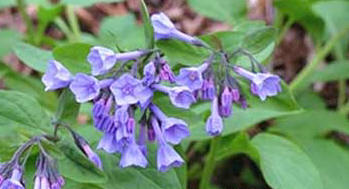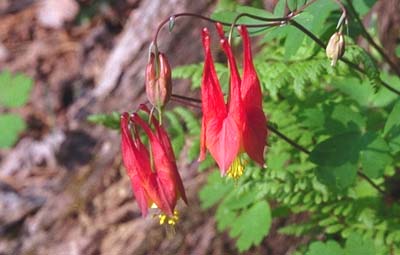Annette Ipsan
Frederick County Master Gardener Program
A: Many plants thrive in shade, adapting to lower light levels and moist conditions. Entire gardening books are devoted to the subject, giving recommendations for everything from groundcovers to trees. Here are a few of my favorites:
Is there a more classic cottage garden plant for spring than the bleeding heart? Old-fashioned bleeding heart (Dicentra spec tabilis) is a wonderful perennial with cascades of rose and white blooms that resemble hearts. The traditional variety blooms
in April and May, then ---like all ephemerals -- dissolves quietly back into the soil with its foliage. I delight in Dicentra eximia, a fringed bleeding heart that keeps its delicate foliage and reblooms into fall.
|

Virginia Blubells
Mertensia virginica)

Columbine (Aquilegia canadensis) |
Spring also brings the nod-ding clusters of blue and pink bells that are Virginia bluebells (Mertensia pulmonarioides). Seeing them each year always brings memories of quiet walks along stream banks strewn with these beauties. Like bleeding heart,
they fade and disappear after blooming to save energy for next year's show.
Columbine (Aquilegia) is another cottage garden favorite that struts its stuff in spring. Native columbine blooms in concert with the hummingbirds' arrival in April, while cultivated varieties sport their bell-shaped blooms in late spring and early
summer. Look for striking two-tone color combos and new varieties with larger blooms or groundcover forms.
One of my favorite fragrances, lily of the valley (Convallaria majalis), has a special place of honor in my shade gar-den. An excellent groundcover, this rhizomatous perennial sprouts tiny white flowers in May that pack a sweet, intense fragrance I
can sense yards away. Newer varieties have soft pink blooms or variegated foliage for added interest.
No old-fashioned shade gar-den is complete without the magnificent blowsy blooms of the hydrangea. Available in shades of pink, blue and white, some varieties of this shrub can be manipulated to bloom in different colors by lowering or raising the
soil pH. Yes, you can fool Mother Nature. Decidedly different varieties include petite Pia, the lacecap species, oakleaf types and the novel climbing hydrangea. Look for bloom times from summer to fall.
With over 150 varieties to choose from, there is a viburnum for every taste and location. I have several different types of this versatile shrub with its clustered blooms, but the leatherleaf viburnum does best in my shade garden. Pick the right
plant for your level of shade and look for the added bonus of bird-attracting berries. Viburnum can bloom in spring, summer, fall or winter, and some have striking autumn color.
Astilbe steals the show in late June and July. With its feathery flower clusters and interesting foliage, it adds impact, movement and an airy quality. For best effect, plant it in clumps or drifts throughout your shade garden. You'll find this
reliable perennial in pink, red, white, peach and many other colors.
Ferns are the backdrop for my shade garden. I love them all, from the towering ostrich fern to the low-growing groundcovers. Autumn fern, cinnamon fern, Christmas fern and tassel fern are just a few of the species worth considering. I'm particularly
fond of the Japanese painted fern with its splashes of silver and red.
I have an ongoing list of plants I'd like to add to my shade garden. At the top of that list are three perennials: variegated Jacob's ladder (Polemonium) with its knockout foliage, delicate forget-me-not (Myosotis) in pink and blue and Siberian
bugloss (Brunnera macrophylla), which is much prettier than its name.
I hope this gives you plenty of ideas for creating your own shade garden. Remember less light never means fewer options. Delight yourself and your friends with a glorious, colorful shade garden.
Read other articles on plants and gardens